
Heroin, also known as diacetylmorphine and diamorphine among other names, is a morphinan opioid substance synthesized from the dried latex of the opium poppy; it is mainly used as a recreational drug for its euphoric effects. Heroin is used medically in several countries to relieve pain, such as during childbirth or a heart attack, as well as in opioid replacement therapy. Medical-grade diamorphine is used as a pure hydrochloride salt. Various white and brown powders sold illegally around the world as heroin are routinely diluted with cutting agents. Black tar heroin is a variable admixture of morphine derivatives—predominantly 6-MAM (6-monoacetylmorphine), which is the result of crude acetylation during clandestine production of street heroin.
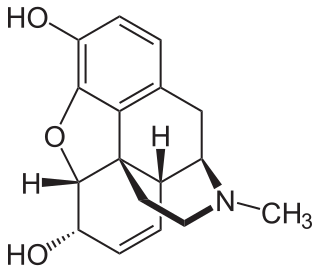
Morphine, formerly also called morphia, is an opiate that is found naturally in opium, a dark brown resin produced by drying the latex of opium poppies. It is mainly used as an analgesic. There are numerous methods used to administer morphine: orally; administered under the tongue; via inhalation; injection into a vein, injection into a muscle, injection under the skin, or injection into the spinal cord area; transdermal; or via administered into the rectal canal suppository. It acts directly on the central nervous system (CNS) to induce analgesia and alter perception and emotional response to pain. Physical and psychological dependence and tolerance may develop with repeated administration. It can be taken for both acute pain and chronic pain and is frequently used for pain from myocardial infarction, kidney stones, and during labor. Its maximum effect is reached after about 20 minutes when administered intravenously and 60 minutes when administered by mouth, while the duration of its effect is 3–7 hours. Long-acting formulations of morphine are sold under the brand names MS Contin and Kadian, among others. Generic long-acting formulations are also available.

Opium is dried latex obtained from the seed capsules of the opium poppy Papaver somniferum. Approximately 12 percent of opium is made up of the analgesic alkaloid morphine, which is processed chemically to produce heroin and other synthetic opioids for medicinal use and for the illegal drug trade. The latex also contains the closely related opiates codeine and thebaine, and non-analgesic alkaloids such as papaverine and noscapine. The traditional, labor-intensive method of obtaining the latex is to scratch ("score") the immature seed pods (fruits) by hand; the latex leaks out and dries to a sticky yellowish residue that is later scraped off and dehydrated.

Laudanum is a tincture of opium containing approximately 10% powdered opium by weight. Laudanum is prepared by dissolving extracts from the opium poppy in alcohol (ethanol).
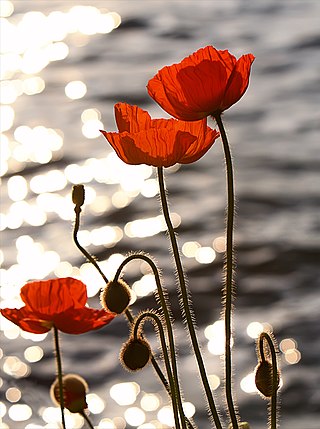
A poppy is a flowering plant in the subfamily Papaveroideae of the family Papaveraceae. Poppies are herbaceous plants, often grown for their colourful flowers. One species of poppy, Papaver somniferum, is the source of the narcotic drug mixture opium, which contains powerful medicinal alkaloids such as morphine and has been used since ancient times as an analgesic and narcotic medicinal and recreational drug. It also produces edible seeds. Following the trench warfare in the poppy fields of Flanders, Belgium, during World War I, poppies have become a symbol of remembrance of soldiers who have died during wartime, especially in the UK, Canada, Australia, New Zealand and other Commonwealth realms.

Papaver somniferum, commonly known as the opium poppy or breadseed poppy, is a species of flowering plant in the family Papaveraceae. It is the species of plant from which both opium and poppy seeds are derived and is also a valuable ornamental plant grown in gardens. Its native range was east of the Mediterranean Sea, but has since been obscured and vastly expanded by introduction and cultivation from ancient times to the present day, being naturalized across much of Europe and Asia.
Traffik is a 1989 British television serial about an illegal drug trade. Its three stories are interwoven, with arcs told from the perspectives of Afghan and Pakistani growers, dealers and manufacturers, German dealers, and British users. It was nominated for six BAFTA Awards, winning four, including for Best Drama Series or Serial. It also won an International Emmy Award for best drama. The 2000 crime drama film Traffic, directed by Steven Soderbergh, was based on the miniseries. In turn, the 2004 American television miniseries Traffic was based on both versions.
The Misuse of Drugs Act 1973 is a statute of the Parliament of Singapore that enables authorities to prosecute offenders for crimes involving illegal drugs. The law is designed specifically to grant the Government of Singapore, through its agencies such as the Central Narcotics Bureau, enforcement powers to combat offences such as the trafficking, importation or exportation, possession, and consumption of controlled drugs.

The Golden Triangle is a large, mountainous region of approximately 200,000 km2 (77,000 sq mi) in northeastern Myanmar, northwestern Thailand and northern Laos, centered on the confluence of the Ruak and Mekong rivers. The name "Golden Triangle" was coined by Marshall Green, a U.S. State Department official, in 1971 in a press conference on the opium trade. Today, the Thai side of the river confluence, Sop Ruak, has become a tourist attraction, with the House of Opium Museum, a Hall of Opium, and a Golden Triangle Park, and no opium cultivation.
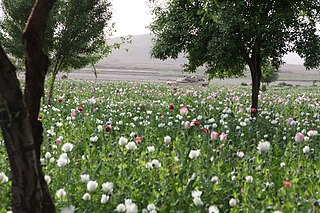
Afghanistan has long had a history of opium poppy cultivation and harvest. As of 2021, Afghanistan's harvest produces more than 90% of illicit heroin globally, and more than 95% of the European supply. More land is used for opium in Afghanistan than is used for coca cultivation in Latin America. The country has been the world's leading illicit drug producer since 2001. In 2007, 93% of the non-pharmaceutical-grade opiates on the world market originated in Afghanistan. By 2019 Afghanistan still produced about 84% of the world market. This amounts to an export value of about US$4 billion, with a quarter being earned by opium farmers and the rest going to district officials, insurgents, warlords, and drug traffickers. In the seven years (1994–2000) prior to a Taliban opium ban, the Afghan farmers' share of gross income from opium was divided among 200,000 families.
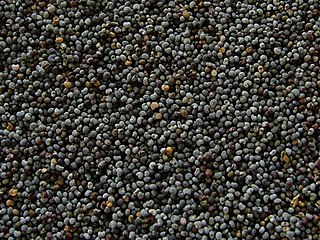
Poppy seed is an oilseed obtained from the poppy plant. The tiny, kidney-shaped seeds have been harvested from dried seed pods by various civilizations for thousands of years. It is still widely used in many countries, especially in Central Europe and South Asia, where it is legally grown, used in food products and sold in shops. The seeds are used whole or ground into meal as an ingredient in many foods – especially in pastry and bread – and they are pressed to yield poppyseed oil.
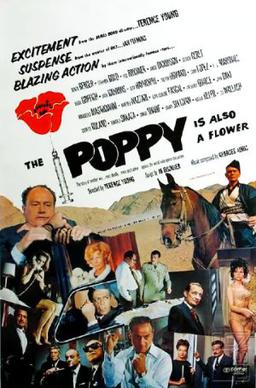
The Poppy Is Also a Flower is a 1966 American-French-Austrian made-for-television spy and anti-drug film. It was originally made under the auspices of the United Nations as part of a series of television specials designed to promote the organization's work. The film was directed by Terence Young and stars Yul Brynner, Omar Sharif, Eli Wallach, Angie Dickinson, Senta Berger, Stephen Boyd, Trevor Howard, Rita Hayworth and Marcello Mastroianni. Grace Kelly narrates.
The illegal drug trade in the People's Republic of China is influenced by factors such as history, location, size, population, and current economic conditions. The People's Republic of China (PRC) has one-sixth of the world's population and a large and expanding economy. China's large land mass, close proximity to the Golden Triangle, Golden Crescent, and numerous coastal cities with large and modern port facilities make it an attractive transit center for drug traffickers. Opium has played an important role in mainland China's history since before the First and Second Opium Wars in the mid-19th century.

Drifting is a 1923 American silent drama film based on the Broadway play Drifting, by John Colton and Daisy H. Andrews. The play had starred Robert Warwick and Alice Brady. The film was directed by Tod Browning and features Priscilla Dean, Wallace Beery, and Anna May Wong. It was produced and distributed by Universal Pictures.
Legal cultivation of opium for medicinal purposes is carried out in India, only in selected areas, under free licensing conditions. India is the world's largest manufacturer of legal opium for the pharmaceutical industry according to the CIA World Factbook. India is one among 12 countries in world where legal cultivation for medical use is permissible within the ambit of United Nations, Single Convention on Narcotic Drugs 1961. In India legal cultivation is done primarily in Madhya Pradesh, Rajasthan and Uttar Pradesh. Despite producing poppy for opium production India depends heavily on imports to meet need of Poppy seed for edible purposes and domestic Codeine demand for medical purposes . Opium is heavily imported from its top producing nations like Afghanistan. There is also an account of Opium black marketing in India.

Opium in Iran is widely available, and the country has been estimated to have the highest per capita number of opioid addicts in the world at a rate of 2.8% of Iranians over age 15. The Iranian government estimates the number of addicts at 2 million. Opium and heroin from Afghanistan and Pakistan—known collectively as the Golden Crescent—pass through Iran's eastern borders in large amounts. Iran burned 56 tons of Illicit Drugs on the International Day against Drug Abuse and Illicit Trafficking.

Crime is present in various forms in Laos.

The history of opium in China began with the use of opium for medicinal purposes during the 7th century. In the 17th century the practice of mixing opium with tobacco for smoking spread from Southeast Asia, creating a far greater demand.

Hop, the Devil's Brew is a 1916 American silent film directed by Lois Weber and Phillips Smalley. Inspired by an exposé of opium trafficking in the Saturday Evening Post, the semidocumentary film starred Smalley as a Customs official and Weber as his opium-addicted wife.
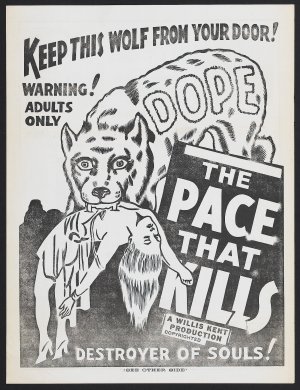
The Pace That Kills is a 1928 American silent exploitation film directed by Norton S. Parker and William O'Connor. The film tells the story of two young people who get involved with a drug dealer and become addicted to opium and cocaine. The plot also dealt with amorality and prostitution. Similar to other movies of the genre, the final film was redone as a film of the same name in 1935 in a sound or "talkie" film format. Footage from The Pace That Kills was incorporated in the later film.
















